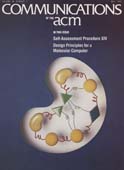May 1985 - Vol. 28 No. 5

Features
On design principles for a molecular computer
If the unique information-processing capabilities of protein enzymes could be adapted for computers, then evolvable, more efficient systems for such applications as pattern recognition and process control are in principle possible.
A self-assessment procedure dealing with the legal issues of computing
The 1984 Snowbird Report: future issues in computer science
This workshop reports that no core description of computer science is universally accepted. A model of the discipline must emphasize global issues over isolated objectives, cooperation over competition.
A study of application program development techniques
A survey of application development techniques in 43 organizations identifies the methods and tools found most effective in application software development.
An application of queueing theory to the design of a message-switching computer system
Inexact or real-world queueing techniques are used to determine that the number of buffers provided in system design is indeed adequate to guard against message loss.
Adaptive exact-fit storage management
Tested against extremes in the characteristics of arrival patterns to dynamic allocation software, the working-set approach outperforms the FIFO method except in the case of completely random request patterns—where the working-set method performs as well as the FIFO method.
Computing in the home: shifts in the time allocation patterns of households
An empirical study of 282 users of home computers was conducted to explore the relationship between computer use and shifts in time allocation patterns in the household. Major changes in time allocated to various activities were detected. Prior experience with computers (i.e., prior to purchase of the home computer) was found to have a significant impact on the time allocation patterns in the household. The study provides evidence that significant behavior changes can occur when people adopt personal computers in their homes.
A polynomial time generator for minimal perfect hash functions
A perfect hash function PHF is an injection F from a set W of M objects into the set consisting of the first N nonnegative integers where N ⩾ M. If N = M, then F is a minimal perfect hash function, MPHF. PHFs are useful for the compact storage and fast retrieval of frequently used objects such as reserved words in a programming language or commonly employed words in a natural language.The mincycle algorithm for finding PHFs executes with an expected time complexity that is polynomial in M and has been used successfully on sets of cardinality up to 512. Given three pseudorandom functions h0, h1, and h2, the mincycle algorithm searches for a function g such that F(w) = (h0(w) + g ° h1(w) + g ° h2(w)) mod N is a PHF.



